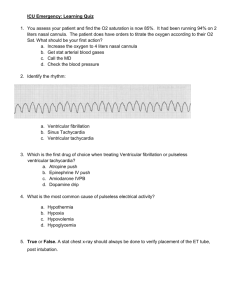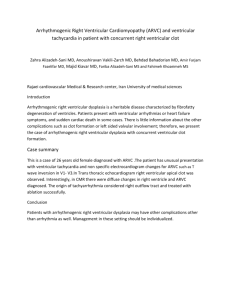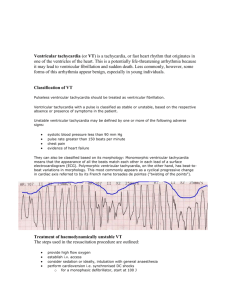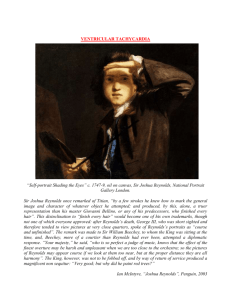ventricular_tachycardia
advertisement
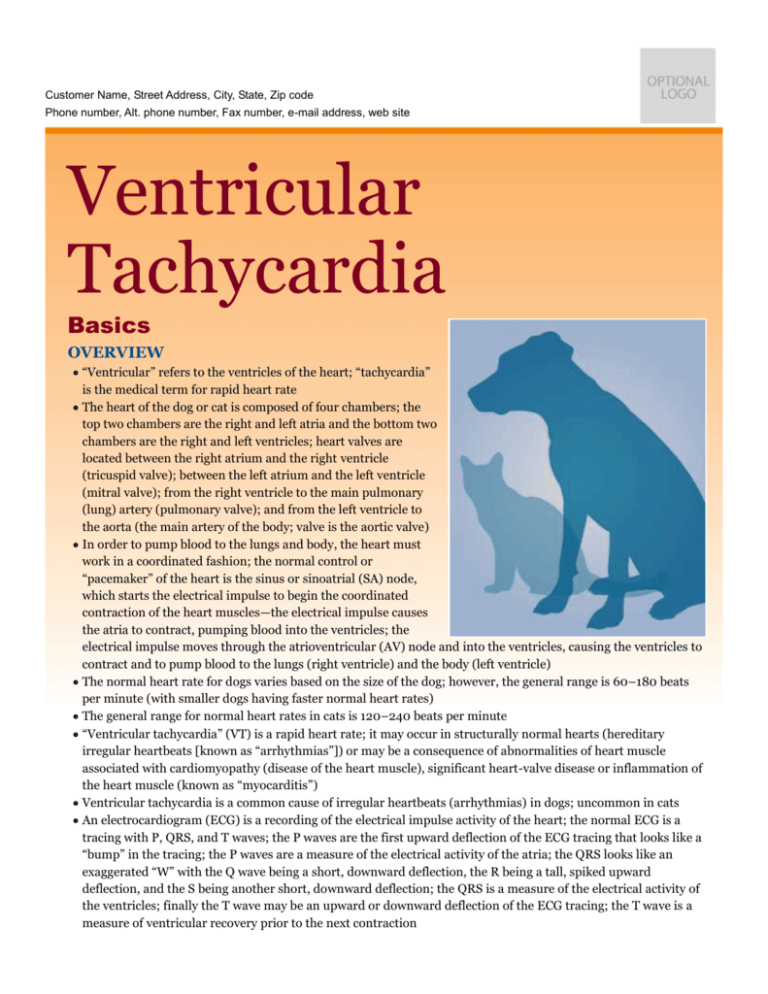
Customer Name, Street Address, City, State, Zip code Phone number, Alt. phone number, Fax number, e-mail address, web site Ventricular Tachycardia Basics OVERVIEW • “Ventricular” refers to the ventricles of the heart; “tachycardia” is the medical term for rapid heart rate • The heart of the dog or cat is composed of four chambers; the top two chambers are the right and left atria and the bottom two chambers are the right and left ventricles; heart valves are located between the right atrium and the right ventricle (tricuspid valve); between the left atrium and the left ventricle (mitral valve); from the right ventricle to the main pulmonary (lung) artery (pulmonary valve); and from the left ventricle to the aorta (the main artery of the body; valve is the aortic valve) • In order to pump blood to the lungs and body, the heart must work in a coordinated fashion; the normal control or “pacemaker” of the heart is the sinus or sinoatrial (SA) node, which starts the electrical impulse to begin the coordinated contraction of the heart muscles—the electrical impulse causes the atria to contract, pumping blood into the ventricles; the electrical impulse moves through the atrioventricular (AV) node and into the ventricles, causing the ventricles to contract and to pump blood to the lungs (right ventricle) and the body (left ventricle) • The normal heart rate for dogs varies based on the size of the dog; however, the general range is 60–180 beats per minute (with smaller dogs having faster normal heart rates) • The general range for normal heart rates in cats is 120–240 beats per minute • “Ventricular tachycardia” (VT) is a rapid heart rate; it may occur in structurally normal hearts (hereditary irregular heartbeats [known as “arrhythmias”]) or may be a consequence of abnormalities of heart muscle associated with cardiomyopathy (disease of the heart muscle), significant heart-valve disease or inflammation of the heart muscle (known as “myocarditis”) • Ventricular tachycardia is a common cause of irregular heartbeats (arrhythmias) in dogs; uncommon in cats • An electrocardiogram (ECG) is a recording of the electrical impulse activity of the heart; the normal ECG is a tracing with P, QRS, and T waves; the P waves are the first upward deflection of the ECG tracing that looks like a “bump” in the tracing; the P waves are a measure of the electrical activity of the atria; the QRS looks like an exaggerated “W” with the Q wave being a short, downward deflection, the R being a tall, spiked upward deflection, and the S being another short, downward deflection; the QRS is a measure of the electrical activity of the ventricles; finally the T wave may be an upward or downward deflection of the ECG tracing; the T wave is a measure of ventricular recovery prior to the next contraction • Ventricular tachycardia is diagnosed by changes in the ECG, including three or more abnormal beats that begin in the ventricle and causes the heart muscle to contract too quickly (known as “ventricular premature contractions”) in a row; if P waves are visible, they are not associated with the QRS complexes; QRS complexes typically are wide and bizarre in appearance • Rapid ventricular heart rate (ventricular tachycardia) may be intermittent (paroxysmal) or sustained • Certain breeds (boxers, Doberman pinschers, and German shepherd dogs) have characteristic, breed-specific ECG changes GENETICS • Heart-muscle disease of the right ventricle (known as “arrhythmogenic right ventricular cardiomyopathy” or ARVC) in boxers and heart-muscle disease characterized by a weak, flabby heart and ventricular tachycardia (known as “dilated cardiomyopathy with ventricular tachycardia”) in Doberman pinschers are both inherited as autosomal dominant traits • Ventricular irregular heartbeats (arrhythmias) and sudden cardiac death are hereditary in German shepherd dogs; mode of inheritance involves multiple genes (known as a “polygenic trait”) SIGNALMENT/DESCRIPTION OF PET Species • Dogs • Cats Breed Predilections • Commonly seen in large-breed dogs with heart-muscle disease (cardiomyopathy), especially boxers and Doberman pinschers • German shepherd dogs with sudden cardiac death Mean Age and Range • All age groups, if not breed-specific ventricular tachycardia • Boxers with heart-muscle disease of the right ventricle (arrhythmogenic right ventricular cardiomyopathy) usually present to the veterinarian at 4–6 years of age, frequency and severity of the irregular heart beat (arrhythmia) usually increases over time • Doberman pinschers with “hidden” heart-muscle disease (known as “occult cardiomyopathy”) typically develop ventricular irregular heartbeats (arrhythmias) beginning at 3–6 years of age, but ventricular arrhythmias can occur much later in life; frequency and severity of the arrhythmia usually increases over time • German shepherd dogs develop ventricular irregular heartbeats (arrhythmias) at 12–16 weeks of age; the frequency and severity of arrhythmias increases until 24–30 weeks of age; after 8 months of age, the arrhythmia severity stabilizes or starts to decrease SIGNS/OBSERVED CHANGES IN THE PET • May have no clinical signs • Fainting (known as “syncope”) • Weakness • Exercise intolerance • Sudden death • Rapid heart rate (tachycardia) • Femoral pulses may vary or be weak • Heart murmur may be present • Signs of congestive heart failure may be present; signs include cough; difficulty breathing (known as “dyspnea”); bluish discoloration of the skin and moist tissues (known as “mucous membranes”) of the body caused by inadequate oxygen levels in the red blood cells (condition known as “cyanosis”); “congestive heart failure” is a condition in which the heart cannot pump an adequate volume of blood to meet the body's needs CAUSES • Heart-muscle disease (cardiomyopathy) • Congenital (present at birth) heart defects (especially subaortic stenosis, a birth defect involving narrowing of the area just below the aortic valve, the heart valve from the left ventricle to the aorta [the main artery of the body]) • Long-term (chronic) heart-valve disease • Condition in which the stomach dilates with gas and/or fluid (known as “gastric dilatation”), and subsequently rotates around its short axis (known as “volvulus”)—condition known as “gastric dilatation-volvulus” or “bloat” • Traumatic or infectious inflammation of the heart muscle (myocarditis) • Digitalis toxicity; digitalis is a heart medication • Increased levels of thyroid hormone (known as “hyperthyroidism”) in cats • Heart tumors or cancer • Inflammation of the pancreas (known as “pancreatitis”) RISK FACTORS • Low levels of potassium in the blood (known as “hypokalemia”) or high levels of potassium in the blood (known as “hyperkalemia”) • Low levels of magnesium in the blood (known as “hypomagnesemia”) • Acid–base disturbances • Low levels of oxygen in the blood (known as “hypoxemia”) • Cancer (such as hemangiosarcoma of the heart or spleen) Treatment HEALTH CARE • Varies with underlying cause • Most pets with intermittent ventricular tachycardia can be worked up safely to check for underlying diseases (diagnostics may include electrocardiogram [a recording of the electrical activity of the heart], echocardiogram [use of ultrasound to evaluate the heart and major blood vessels], and blood work) and establish a true baseline of the quantity and quality of the irregular heartbeats (arrhythmias) by a 24-hour Holter monitoring (where the pet wears a “vest” in which a continuous, mobile battery-powered ECG monitor has been placed; the ECG recording is performed over several hours, giving a better overall picture of the heart rate and rhythm) • Correct any low levels of potassium in the blood (hypokalemia) or low levels of magnesium in the blood (hypomagnesemia), if possible, prior to instituting medical therapy • If a pet is unstable (such as being unable to stand, weak or has frequent fainting [syncope]), immediate intravenous treatment in a hospital setting with continuous ECG monitoring may be required • Once the irregular heart beat (arrhythmia) is controlled and the pet is stable, oral medication should be instituted • To date, no medical treatment is available to prevent sudden death in pets afflicted with rapid, irregular ventricular heart beats (known as “ventricular tachyarrhythmias”) ACTIVITY • Generally speaking, no benefit has been demonstrated to restrict exercise • Boxers tend to have an increased incidence of rapid ventricular heart beats (ventricular tachycardia) during excitement, so owners should know what specific situations to avoid to prevent excitement (if possible) SURGERY • When possible, determine the cause of the irregular heartbeats (arrhythmias) and treat it prior to inducing general anesthesia for any reason • Avoid using medications that may worsen the irregular heartbeats (arrhythmias), such as xylazine, medetomidine, or thiopental • Mask inductions for anesthesia are not recommended in inadequately sedated pets with irregular ventricular heart beats (ventricular arrhythmias) • Continuous electrocardiogram (a recording of the electrical activity of the heart) monitoring while the pet is anesthetized Medications Medications presented in this section are intended to provide general information about possible treatment. The treatment for a particular condition may evolve as medical advances are made; therefore, the medications should not be considered as all inclusive DOGS • Sudden (acute) life-threatening, rapid, irregular ventricular heart beats (ventricular tachycardia)—slowly administer lidocaine into the vein (intravenous administration) to convert to a normal heart rhythm (known as “sinus rhythm”); follow with lidocaine continuous rate intravenous infusion • If ventricular tachycardia does not respond to lidocaine—slowly administer procainamide into the vein to convert to a normal heart rhythm (sinus rhythm); follow with procainamide infusion • If the pet does not respond to lidocaine or procainamide, slowly administer esmolol (a short-acting β-blocker) into the vein or as a constant rate infusion • Long-term (chronic) rapid, irregular ventricular heart beats (ventricular tachycardia) in a stable pet—sotalol may be administered or a combination of mexiletine with a β-blocker (such as atenolol or sotalol) may be more effective for ventricular tachycardia that is not responsive to medical treatment (known as “refractory ventricular tachycardia”), especially in boxers • Combination of mexiletine and sotalol is most effective in German shepherd dogs • Consider amiodarone for ventricular tachycardia that is not responsive to medical treatment (refractory ventricular tachycardia); amiodarone is slowly effective and it has several potential side effects that you should discuss with your dog's veterinarian CATS • Use lidocaine cautiously and only for sustained rapid, irregular ventricular heart beats (ventricular tachycardia), as seizures are a common side effect of lidocaine in cats • Atenolol is the preferred treatment in cats • Consider sotalol for ventricular tachycardia that is not responsive to medical treatment (refractory ventricular tachycardia) Follow-Up Care PATIENT MONITORING • Holter monitoring (where the pet wears a “vest” in which a continuous, mobile battery-powered ECG monitor has been placed; the ECG recording is performed over several hours, giving a better overall picture of the heart rate and rhythm) is preferred for monitoring severity of the rapid, irregular ventricular heart beat (ventricular tachycardia) and effectiveness of treatment • Follow-up 24-hour Holter monitoring is required to test effectiveness of treatment to control the irregular heart beat (arrhythmia) • Serial electrocardiograms (recordings of the electrical activity of the heart) and telemetry (heart rate and rhythm recordings transmitted to a centralized monitor using radio waves) can be used—not as useful as Holter monitoring because abnormal beats that begin in the ventricle and causes the heart muscle to contract too quickly (ventricular premature contractions) and intermittent rapid ventricular heart rate (paroxysmal ventricular tachycardia) can occur sporadically through the day • Pets receiving digoxin (a heart medication)—serum digoxin levels should be measured after one week of treatment; obtain blood sample for testing 8–10 hours post-pill • Dogs treated with amiodarone—serial blood tests (serum chemistries) are recommended, since increases in liver enzyme activities usually precede onset of clinical signs of amiodarone toxicity; liver enzymes should be measured after 7 days of drug loading and once monthly during maintenance therapy PREVENTIONS AND AVOIDANCE • Correct predisposing factors (such as low levels of potassium in the blood [hypokalemia], low levels of magnesium in the blood [hypomagnesemia], low levels of oxygen in the heart muscle [known as “myocardial hypoxia”], and digoxin toxicity) • Limit significant stress or excitement (if possible) in boxers, as stress and excitement can worsen the rapid heart rate (ventricular tachycardia) POSSIBLE COMPLICATIONS • Fainting (syncope) • Sudden death EXPECTED COURSE AND PROGNOSIS • If cause is metabolic—condition may resolve with a good prognosis • If condition is associated with heart disease—prognosis guarded, because underlying heart disease is likely longterm (chronic) and progressive and therefore, the irregular heartbeats (arrhythmias) may worsen too over time; presence of significant rapid, irregular ventricular heart beat (ventricular tachycardia) increases risk of sudden death • If ventricular tachycardia is associated with hemangiosarcoma of the heart and/or spleen, the long-term prognosis is grave; “hemangiosarcoma” is a type of cancer • Approximately 50% of German shepherd dogs with more than 10 runs of rapid, irregular ventricular heart beats (ventricular tachycardia) per 24 hours die suddenly; if dogs reach 18 months of age, the probability of sudden death decreases • Unlike boxers with heart-muscle disease of the right ventricle (arrhythmogenic right ventricular cardiomyopathy), Doberman pinschers with heart-muscle disease characterized by a weak, flabby heart and ventricular tachycardia (dilated cardiomyopathy with ventricular tachycardia) may die suddenly during their first fainting (syncopal) episode Key Points • Potential for sudden death Enter notes here Blackwell's Five-Minute Veterinary Consult: Canine and Feline, Fifth Edition, Larry P. Tilley and Francis W.K. Smith, Jr. © 2011 John Wiley & Sons, Inc.


